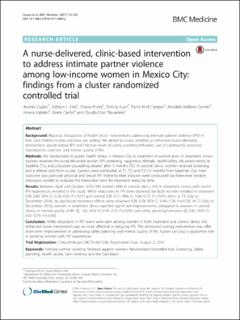Please use this identifier to cite or link to this item:
https://doi.org/10.21256/zhaw-4718Full metadata record
| DC Field | Value | Language |
|---|---|---|
| dc.contributor.author | Gupta, Jhumka | - |
| dc.contributor.author | Falb, Kathryn L. | - |
| dc.contributor.author | Ponta, Oriana | - |
| dc.contributor.author | Xuan, Ziming | - |
| dc.contributor.author | Campos, Paola Abril | - |
| dc.contributor.author | Gomez, Annabel Arellano | - |
| dc.contributor.author | Valades, Jimena | - |
| dc.contributor.author | Cariño, Gisele | - |
| dc.contributor.author | Olavarrieta, Claudia Diaz | - |
| dc.date.accessioned | 2018-09-27T12:01:20Z | - |
| dc.date.available | 2018-09-27T12:01:20Z | - |
| dc.date.issued | 2017 | - |
| dc.identifier.issn | 1741-7015 | de_CH |
| dc.identifier.uri | https://digitalcollection.zhaw.ch/handle/11475/11143 | - |
| dc.description.abstract | Background: Rigorous evaluations of health sector interventions addressing intimate partner violence (IPV) in low- and middle-income countries are lacking. We aimed to assess whether an enhanced nurse-delivered intervention would reduce IPV and improve levels of safety planning behaviors, use of community resources, reproductive coercion, and mental quality of life. Methods: We randomized 42 public health clinics in Mexico City to treatment or control arms. In treatment clinics, women received the nurse-delivered session (IPV screening, supportive referrals, health/safety risk assessments) at baseline (T1), and a booster counselling session after 3 months (T2). In control clinics, women received screening and a referral card from nurses. Surveys were conducted at T1, T2, and T3 (15 months from baseline). Our main outcome was past-year physical and sexual IPV. Intent-to-treat analyses were conducted via three-level random intercepts models to evaluate the interaction term for treatment status by time. Results: Between April and October 2013, 950 women (480 in control clinics, 470 in treatment clinics) with recent IPV experiences enrolled in the study. While reductions in IPV were observed for both women enrolled in treatment (OR, 0.40; 95% CI, 0.28-0.55; P < 0.01) and control (OR, 0.51; 95% CI, 0.36-0.72; P < 0.01) clinics at T3 (July to December 2014), no significant treatment effects were observed (OR, 0.78; 95% CI, 0.49-1.24; P = 0.30). At T2 (July to December 2013), women in treatment clinics reported significant improvements, compared to women in control clinics, in mental quality of life (β, 1.45; 95% CI, 0.14-2.75; P = 0.03) and safety planning behaviors (β, 0.41; 95% CI, 0.02-0.79; P = 0.04). Conclusion: While reductions in IPV levels were seen among women in both treatment and control clinics, the enhanced nurse intervention was no more effective in reducing IPV. The enhanced nursing intervention may offer short-term improvements in addressing safety planning and mental quality of life. Nurses can play a supportive role in assisting women with IPV experiences. | de_CH |
| dc.language.iso | en | de_CH |
| dc.publisher | BioMed Central | de_CH |
| dc.relation.ispartof | BMC Medicine | de_CH |
| dc.rights | https://creativecommons.org/licenses/by/4.0/ | de_CH |
| dc.subject | Health sector | de_CH |
| dc.subject | Intimate partner violence | de_CH |
| dc.subject | Violence against women | de_CH |
| dc.subject | Quality of life | de_CH |
| dc.subject.ddc | 306: Kultur | de_CH |
| dc.subject.ddc | 610.73: Pflege | de_CH |
| dc.title | A nurse-delivered, clinic-based intervention to address intimate partner violence among low-income women in Mexico City : findings from a cluster randomized controlled trial | de_CH |
| dc.type | Beitrag in wissenschaftlicher Zeitschrift | de_CH |
| dcterms.type | Text | de_CH |
| zhaw.departement | School of Management and Law | de_CH |
| zhaw.organisationalunit | Institut für Verwaltungs-Management (IVM) | de_CH |
| dc.identifier.doi | 10.21256/zhaw-4718 | - |
| dc.identifier.doi | 10.1186/s12916-017-0880-y | de_CH |
| dc.identifier.pmid | 28697769 | de_CH |
| zhaw.funding.eu | No | de_CH |
| zhaw.issue | 128 | de_CH |
| zhaw.originated.zhaw | Yes | de_CH |
| zhaw.publication.status | publishedVersion | de_CH |
| zhaw.volume | 15 | de_CH |
| zhaw.publication.review | Peer review (Publikation) | de_CH |
| Appears in collections: | Publikationen School of Management and Law | |
Files in This Item:
| File | Description | Size | Format | |
|---|---|---|---|---|
| A nurse-delivered_BMC Med 2017-1.pdf | 1.04 MB | Adobe PDF |  View/Open |
Show simple item record
Gupta, J., Falb, K. L., Ponta, O., Xuan, Z., Campos, P. A., Gomez, A. A., Valades, J., Cariño, G., & Olavarrieta, C. D. (2017). A nurse-delivered, clinic-based intervention to address intimate partner violence among low-income women in Mexico City : findings from a cluster randomized controlled trial. BMC Medicine, 15(128). https://doi.org/10.21256/zhaw-4718
Gupta, J. et al. (2017) ‘A nurse-delivered, clinic-based intervention to address intimate partner violence among low-income women in Mexico City : findings from a cluster randomized controlled trial’, BMC Medicine, 15(128). Available at: https://doi.org/10.21256/zhaw-4718.
J. Gupta et al., “A nurse-delivered, clinic-based intervention to address intimate partner violence among low-income women in Mexico City : findings from a cluster randomized controlled trial,” BMC Medicine, vol. 15, no. 128, 2017, doi: 10.21256/zhaw-4718.
GUPTA, Jhumka, Kathryn L. FALB, Oriana PONTA, Ziming XUAN, Paola Abril CAMPOS, Annabel Arellano GOMEZ, Jimena VALADES, Gisele CARIÑO und Claudia Diaz OLAVARRIETA, 2017. A nurse-delivered, clinic-based intervention to address intimate partner violence among low-income women in Mexico City : findings from a cluster randomized controlled trial. BMC Medicine. 2017. Bd. 15, Nr. 128. DOI 10.21256/zhaw-4718
Gupta, Jhumka, Kathryn L. Falb, Oriana Ponta, Ziming Xuan, Paola Abril Campos, Annabel Arellano Gomez, Jimena Valades, Gisele Cariño, and Claudia Diaz Olavarrieta. 2017. “A Nurse-Delivered, Clinic-Based Intervention to Address Intimate Partner Violence among Low-Income Women in Mexico City : Findings from a Cluster Randomized Controlled Trial.” BMC Medicine 15 (128). https://doi.org/10.21256/zhaw-4718.
Gupta, Jhumka, et al. “A Nurse-Delivered, Clinic-Based Intervention to Address Intimate Partner Violence among Low-Income Women in Mexico City : Findings from a Cluster Randomized Controlled Trial.” BMC Medicine, vol. 15, no. 128, 2017, https://doi.org/10.21256/zhaw-4718.
Items in DSpace are protected by copyright, with all rights reserved, unless otherwise indicated.